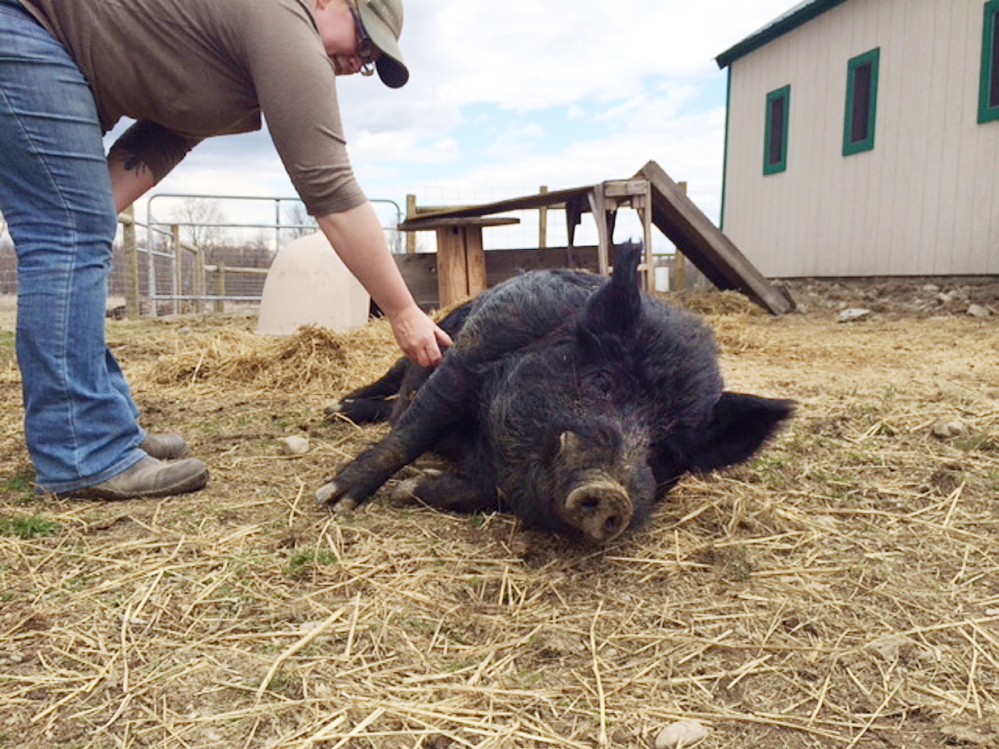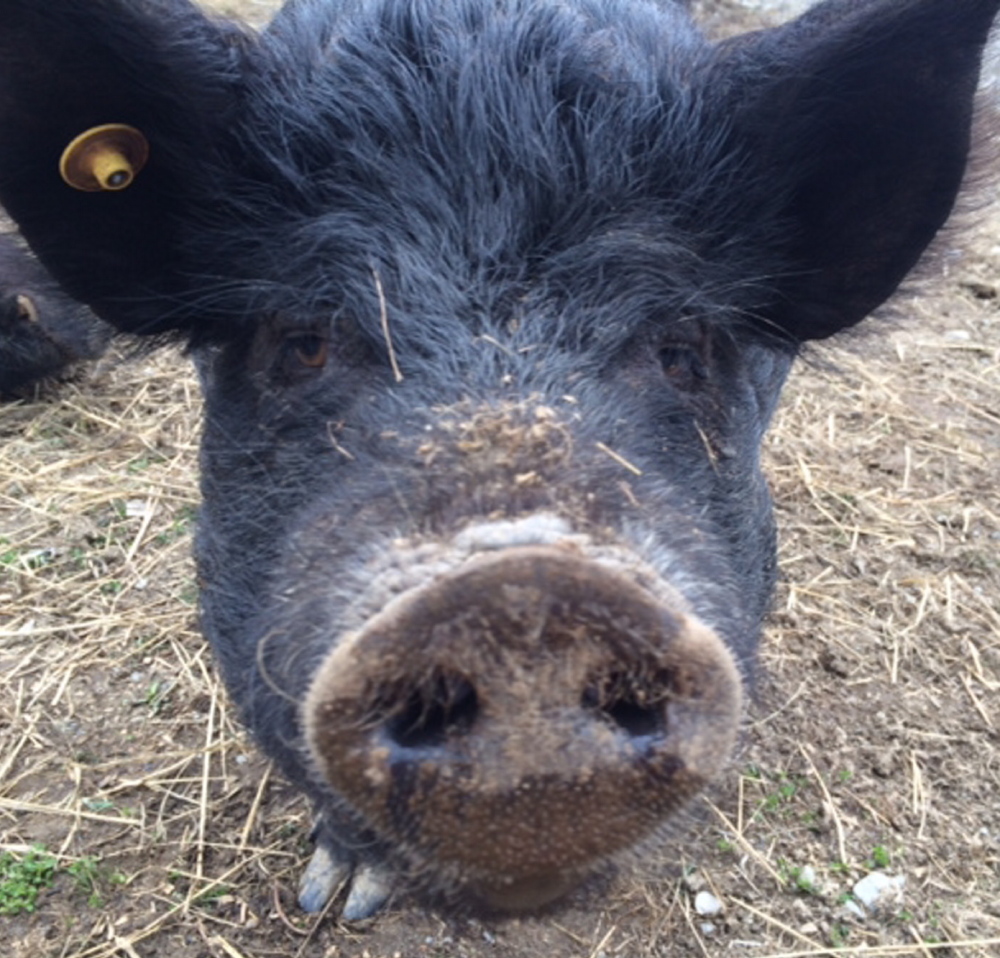UNITY — A pair of rare hogs that were thought to be extinct a decade ago are the newest animals to join the fledgling livestock program at Unity College.
Luna and Lurch are American guinea hogs, a breed of meat pigs that were at one time commonly found on homesteads and farms primarily in the Southeast. They recently moved to their new home in the livestock barn at Unity College, where efforts are underway to create a refuge for heritage breeds, traditional livestock that have been bred to develop the genetic traits best suited to an environment.
There are only 1,267 American guinea hogs in existence, according to The Livestock Conservancy, a nonprofit group dedicated to the preservation of heritage breeds.
Guinea hogs have made a major comeback in the United States after reaching the brink of extinction. The breed was believed to be extinct in 2004, until conservationists found a single farm in Georgia where there were fewer than 50 of the rare pigs. As of 2006, there were only 75 in the world, but a concentrated effort by livestock management groups and the growth in popularity of the guinea hog meat have contributed to its resurgence. Its meat is traditionally used as a source of lard and is fattier than most pork.
Luna and Lurch have been at their new home at Unity College for about a week. They originally came from Fort Lewis Preservation Farm in Jefferson, and most recently belonged to Unity farmer Kyle McCaskill, owner of Sunnywood Farm.
Intrigued by the uniqueness of the hogs, McCaskill, 54, said she and her husband sought to bring them to their farm, where their efforts to be self-sufficient include living with no electricity or running water.
But when her husband, Joe Dupere, died of a heart attack, running the farm and caring for the chickens, goats and hogs became too much work for one person.
“I had to downsize, and the hogs – despite being so important to me – had to go,” McCaskill said.
The college, which started its livestock barn last fall, bought the pair of pigs for $600, to add to their growing collection that includes San Clemente goats, Delaware chickens, Katahdin sheep and Silver Fox rabbits.
The hogs seem well-adjusted to their new home.
Luna, the smaller of the two, is round-bellied and lazy as she waits for the birth of several piglets due June 8.
Lurch has a habit of itching his back against the wooden posts in the pen, wearing most of his wiry black hair off his back and sides. Two tiny tusks peek out from under his thick snout that he uses to forage through the pen.
“They are reminiscent of wild boars, which I think can be intimidating for most people,” barn manager Megan Anderson said Friday. “But really they’re just lazy and adorable.”
MORE THAN MEAT
Like the other heritage breeds at the barn, the hogs’ top purpose is to serve the campus dining hall. But the importance of preserving them goes beyond the appetites of hungry students.
“It’s difficult to think about, but it really all boils down to genetic diversity,” said Ryan Walker, communications manager for The Livestock Conservancy. “Whenever you have a species of animal, their health, vigor and strength is stronger with a broader genetic base.”
There are about 30 commonly raised breeds of pigs in the United States and 10 heritage breeds, according to the conservancy, which is based in North Carolina. In order for swine to be considered heritage, they must be purebred, currently or at one point endangered and have an established breeding history in the United States since at least 1925.
The guinea hog, a heritage breed, is unique among pigs because it is the only lard hog left in existence.
Its exact origin in unknown, but the pig is believed to have been brought to the U.S. from England in the late 1700s, said Walker.
Some thought that the animal originated from the African nation of Guinea because of its name, although the word actually refers to the small size of the pig, according to Walker. American guinea hogs can weigh up to 200 pounds, while other breeds may weigh up to 800 pounds.
The decline of the population coincides with the trend toward eating more lean meat and the tendency of early American homesteaders to crossbreed swine. In the 1800s, about a dozen breeds of pigs were lost because of crossbreeding to create new breeds like Yorkshire, Hampshire and Chester White, that are still popular today.
The meat of the guinea hog is more fatty than other hog breeds, which makes it a good producer of lard for cooking, but by the end of the 20th century people were starting to eat more lean meat and a lot of lard hogs became extinct.
LOST AND FOUND
In 2004, the American guinea hog was believed to be among them, until the group in Georgia was found.
The farmer “didn’t want anyone to know he had them and just kind of kept them for himself,” Walker said. “We let him know how important they were, that he clearly had the last of the breed and we started a conservation breeding program by placing some of them with other farmers. All of our guinea hogs that are around these days have descended from that little population of less than 50 animals.”
The conservancy and other groups like the American Guinea Hog Association have worked to increase promotion of the animals, and so far it has been successful. There are about 200 registered breeders in the United States and 1,267 hogs.
“I think a big turning point was when high-end chefs started taking notice of them,” Walker said. “One of the farmers here went and handed out free meat to all the chefs in Charleston and Savannah and they just loved it.”
One of the most notable champions of the American guinea hog is Charleston, South Carolina, chef Craig Deihl, whose restaurant Cypress is known for its charcuterie plates – dishes made from cured meat, in this case bacon and sausage made from the American guinea hog.
In Maine, the American guinea hog is also becoming part of the local food movement. In October, Freeport’s Wolfe’s Neck Farm entered a partnership with Portland chef Masa Miyake. The farm agreed to raise nine American Guinea hogs for Miyake’s chain of Japanese restaurants.
McCaskill said that getting people to recognize the value of the pig as a food source is critical to the preservation of the breed. She has been using the lard to cook and make soaps for years.
“Once we got them we just found them delightful,” she said. “I mean they’re still pigs, like pigs that you have in your yard, and we feel it’s important to use them for food because if they don’t become valued as a food source people won’t keep breeding them. That’s the best way to save them, is to help people want to use them for food.”
Send questions/comments to the editors.




